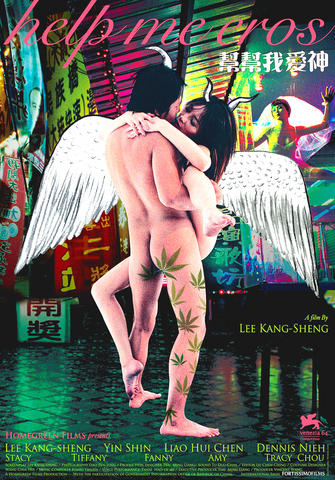To help promote their latest film, Help Me Eros (幫幫我愛神), Lee Kang-sheng (李康生) and Tsai Ming-liang (蔡明亮) have taken to the streets - they've embarked on a tour around Taiwan, giving lectures at universities that are free and open to the general public.
Tsai and Kang are both major figures in Taiwanese New Wave cinema. Tsai has directed eight-feature length films, all starring Kang, and he was executive producer for Kang's 2003 directorial debut, The Missing (不見). Help Me Eros, to be released on Jan. 11 in Taiwan, is Kang's follow-up to The Missing. Tsai is again contributing as executive producer.
Help Me Eros tells the tale of Ah Jie (Kang), a broke and destitute man who spends his days tending the marijuana plants he grows in a wardrobe. The stoner calls a hotline for help and gets to know Chyi (Liao Hui-chen, 廖慧珍), whom he falls in love with. Chyi repeatedly rejects Ah Jie, so he hits on Shin (Ivy Yi, 尹馨), a "betel nut beauty" who has a stall near his apartment.

PHOTO: LIBERTY TIMES
Though Kang and Tsai's works regularly show at the world's most prestigious film festivals and draw comparisons to French New Wave films of the 1950s and 1960s, they rarely meet with box office success.
To promote Eros, Kang and Tsai have sold tickets to pedestrians in the Ximending shopping zone (西門町) and at Shilin Night Market (士林夜市).
The lectures are in Chinese and feature a showing of the trailer to Help Me Eros, a lecture by both Kang and Tsai and a question-and-answer session.
Today from 3pm to 5pm they'll be at National Chengchi University (政治大學) and from 7pm to 9pm at National Taiwan University of Arts (台灣藝術大學). On Wednesday from 1pm to 3pm they'll be at National Hsinchu University of Education (新竹教育大學) and from 5pm to 7pm at Chung Yuan Christian University (中原大學).
Further information can be found at bloguide.ettoday.com/helpmeeros.

Nov. 11 to Nov. 17 People may call Taipei a “living hell for pedestrians,” but back in the 1960s and 1970s, citizens were even discouraged from crossing major roads on foot. And there weren’t crosswalks or pedestrian signals at busy intersections. A 1978 editorial in the China Times (中國時報) reflected the government’s car-centric attitude: “Pedestrians too often risk their lives to compete with vehicles over road use instead of using an overpass. If they get hit by a car, who can they blame?” Taipei’s car traffic was growing exponentially during the 1960s, and along with it the frequency of accidents. The policy

Hourglass-shaped sex toys casually glide along a conveyor belt through an airy new store in Tokyo, the latest attempt by Japanese manufacturer Tenga to sell adult products without the shame that is often attached. At first glance it’s not even obvious that the sleek, colorful products on display are Japan’s favorite sex toys for men, but the store has drawn a stream of couples and tourists since opening this year. “Its openness surprised me,” said customer Masafumi Kawasaki, 45, “and made me a bit embarrassed that I’d had a ‘naughty’ image” of the company. I might have thought this was some kind

What first caught my eye when I entered the 921 Earthquake Museum was a yellow band running at an angle across the floor toward a pile of exposed soil. This marks the line where, in the early morning hours of Sept. 21, 1999, a massive magnitude 7.3 earthquake raised the earth over two meters along one side of the Chelungpu Fault (車籠埔斷層). The museum’s first gallery, named after this fault, takes visitors on a journey along its length, from the spot right in front of them, where the uplift is visible in the exposed soil, all the way to the farthest

The room glows vibrant pink, the floor flooded with hundreds of tiny pink marbles. As I approach the two chairs and a plush baroque sofa of matching fuchsia, what at first appears to be a scene of domestic bliss reveals itself to be anything but as gnarled metal nails and sharp spikes protrude from the cushions. An eerie cutout of a woman recoils into the armrest. This mixed-media installation captures generations of female anguish in Yun Suknam’s native South Korea, reflecting her observations and lived experience of the subjugated and serviceable housewife. The marbles are the mother’s sweat and tears,